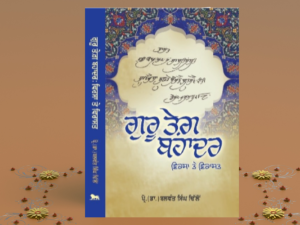Vishal Sangu is the author of this online publication (Dissertation) on Academia.edu. It has six Chapters followed by an exhaustive Bibliography. The young author displays a clear understanding of Sikh ethos, history, philosophy, and politics. He uses Sikhi in place of Sikhism to denote practice of Sikh religion which is a unique idea. In introduction, “Understanding Sikhi” is the main theme for discussion. He goes on to elaborate his understanding of Sikhi: “Sikhi is a world-affirming tradition, meaning enlightenment can be achieved without renouncing the world, as the sacred text of Sikhi, the Guru Granth Sahib states: ‘the earth is placed, the place for the righteous action’ [1]. Implementing the teachings of Sikhi in a political and religious realm”. His argument underpins the concept of miri (political/temporal) and piri (spiritual/transcendent) of Sikhi.
The author tries to juxtapose Sikhi in comparison to other Indian religious traditions: “Sikhi does agree with Hinduism in terms of philosophical beliefs of karma and dharma and agrees with Islam through the belief in a monotheistic God. Guru Nanak emphasised a spiritual Sikhi, influenced by bhakti and Sufi traditions in Punjab. Guru Nanak emphasised questioning philosophy and questioning social life; with an emphasis on the self and not renouncing the world to achieve liberation”. He traces the roots of demand for a separate Sikh state in another concept of Sikhi: “Sikhi is a sant-sipahi (saint-soldier) tradition. This definition of Sikhi is important to understand the call for statehood, as this was the rhetoric used for the justification of Khalistan”.
Chapter 2 is a core Chapter defining “Relationship between religion and ethnonationalism”. The author makes a bold political statement derived from the concept of Akal Takhat: “Punjab being considered a separate state from India is rooted firstly in the Akal Takht, a symbol of
*A Dissertation submitted in fulfilment on undergraduate degree in Theology and Religious Studies, Department of Theology and Religious Studies, University of Chester, England, UK
political sovereignty and where spiritual and political concerns of Sikh people can be addressed. This is demonstrated through the symbolism of two swords: ‘piri’ (spiritual authority) and ‘miri’ (temporal authority)”. The author describes the need for creation of Khalsa by Guru Gobind Singh and its mission: “An army of baptised Sikhs, with an identity different to Hindu’s and Muslims in control of India. With Khalsa being an image of the Gurus, ‘the disciple of the Khalsa required them to remain armed, and with unshorn hair’. The Gurus Khalsa had to be armed to fight oppression and had a look which distinguished them from the Muslims and Hindus through keeping their hair. The efforts of the Khalsa through the leaderships of the Gurus led to the first Sikh empire (1799-1849)”.
The author premised that call for Khalistan is based on three historical facts: (1) The political oppression of Mughal rulers against the Sikhs; (2) Partition of India in 1947 based on two nation theory ignoring the claim of Sikhs for creation of Khalistan; (3) The present government’s move towards a ‘Hindu India’. The message of equality, fraternity, and freedom is inbuilt in Sikh psyche as preached by the Gurus in Guru Granth Sahib and in creation of the Khalsa. The author concludes: “The transition of the religious community to an ethnonationalist claim for statehood is one which is convoluted through history and the Partition of India neglecting the high majority of Sikhs in Punjab”.
Author defines Ethnonationalism as follows: “It is a form of nationalism where the nation is defined in terms of ethnicity, holding a shared heritage, common language, common faith and common ethnic ancestry. Rather than allegiance to common cultural traditions, ethnic nationalism emphasises narratives of common descent” [2]. The rise of nationalism in India was a result of the divide of religion in the British-Raj. Sikh identity remained religious throughout the history of Sikhi but after the calls for a sovereign state, it becomes an ethnonationalist identity. This new Sikhi identity poses a problematic situation: “The modern conception of a Sikh ethnonationalist identity in India is not possible due to the ‘readjustment of relations between central and state governments and the liberalization of the Indian economy’ [3]”.
Chapter 3 gives a bird’s eye view of “History of India” with focus on Mughal rule in India; Sikh Empire; and British rule. The author brings forth the idea of Sikh sovereignty in Punjab: “Banda Singh’s leadership was short lived, but the impact on Punjab was colossal. Establishing the Dal Khalsa and the capture of Sirhind showcased the political interests the Sikhs had developed. Through the leadership of Guru Gobind Singh and the Khalsa army with Banda Singh at the forefront demonstrated how the religious identity of Sikhs was becoming an ethnonationalist identity with the goal of attaining self-determination in Punjab”.
Chapter 4 describes the reasons for the violence and call of a Sikh state under 3 headings: Partition of India; Rise of Sikh Militancy; and Operation Blue Star. The author captures the mood of Sikhs in the opening para: “In the lead up to the Partition of India there were strong nationalistic surges from Hindus and Muslims, whilst the Sikh nationalistic claims were not as strong. Sikhs would have preferred a united country with a decentralised government, meaning an autonomous secular theocratic Punjab similar to the Sikh empire Ranjit Singh established. Only now being established within a secular pluralistic India”. The implication of the Sikhs being regarded as a separate nation were grave at the time of Partition: “In theory, if Sikhs were to be recognised as a religion separate from Hinduism, a separate Sikh state may be legally entitled due to the Partition being scoped on religious basis”.
The author refers to the rise of Sikh militancy in Punjab and the Anandpur Sahib resolution which was misconstrued by the ruling Congress: “In 1973, the Akali Dal, the Sikh political party in Punjab put together the Anandpur Sahib Resolution. The document calls for more autonomy in Punjab, with the example of power being spread from central to state governments being the main agenda. Due to language used by the Akali Dal, the Anandpur resolution was labelled as religious and was thought to have seceded from the Union of India”. I agree with the views of author: “The labelling of the movement towards Khalistan as solely a religious movement and the Anandpur Resolution alongside of the rise of Bhindranwale is a grave miscalculation and misconception by Congress. Eventually leading to the brutal events of 1984, starting with Operation Blue Star. The government’s aim was to squash followers of Bhindranwale. However, the destruction of the Akal Takht and texts of Guru Granth Sahib and the civilian numbers being disputed led to Sikhs demonstrating an identity of ethnonationalism just as strong prior to the Operation Blue Star”.
In Chapter 5, the author traces the transformation of Sikh religion into the identity of ethnonationalism. The anti-Sikh riots after the assassination of Indira Gandhi, the then Prime Minister of India, became the turning point in Sikh history and creating a sense of alienation among the Sikhs in India and in diaspora. This massacre of innocent Sikhs in many states of India has been termed as the ghallughara, translated to genocide or holocaust, and its use is restricted to the wars between Sikhs and Afghans during 1746 and 1762, retrospectively.
The author highlights the role of Sikh diaspora in the fight for a separate Sikh state: “Recently, from my own observations I have seen an influx of pro-Khalistani music. Many Sikhs or Punjabis are happy with their settlements abroad, whilst affirming the situation in Punjab must be addressed. Whereas some demonstrate strong nationalistic calls for statehood, evoking the language of Khalistan or Khalsa Raj (rule of the Khalsa)”. The author concludes this Chapter with his observation: “Political independence of Punjab as a country is unlikely, due to India and Pakistan both being nuclear powerhouses and the boundaries of Partition making it difficult to reconcile Punjab as a nation state. The calls for statehood, independence and reconciliation for not only 1984 but Empire and Partition have been ignored. Identity of the Sikhs has been controlled and suppressed by the Mughals, British and now Indian Congress and government”.
In Chapter 6, the author sums up his conclusions. His objective of study was to understand why a religious community would make a political claim towards statehood. Vishal Sangu concludes his Dissertation with the remarks: “Sikh calls for nationhood do not come from religious belief, it comes from a history of injustices and oppression throughout Empire, Partition and the events of 1984. The Sikh calls for nationhood are solely political. With religious language and religious rhetoric being adopted for Sikhs to express ideas of nationhood. Political means were not the only avenue for Sikhs to express ideas of identity and nationhood, shown through the definition of a Sikh provided by the SGPC at levels of both the individual and the collective (panth) [4]. The individual and collective affairs of the Sikh community encompass political aspirations considering religious/spiritual identity”.
The author of this Dissertation has done full justice to the topic under discussion. He has consulted all relevant resources to justify his conclusions in this short document of 45 pages. I am of the opinion that the author has adopted an unbiased approach to deal with this complex problem agitating the minds of the Sikhs since their Khalsa Raj of Maharaja Ranjit Singh was annexed by the British in 1849.
References
He established the earth as a home for Dharma. (GGS, Japuji, Pauri 34, P. 7)
- Muller, J.Z. (2008). Us and Them. Current issue, 501 Mar/Apr, pp. 9-14.
- Shani, Giorgio. (2006). Beyond Khalistan? Sikh diasporic identity and critical international theory. Sikh Formations: Religion, Culture, Theory, 1/1, pp. 57-74.
- Judge, S. P. (2004). Politics of Sikh Identity and its Fundamentalist Assertion. Economic and Political Weekly, 39/5, pp. 3947-3954.





